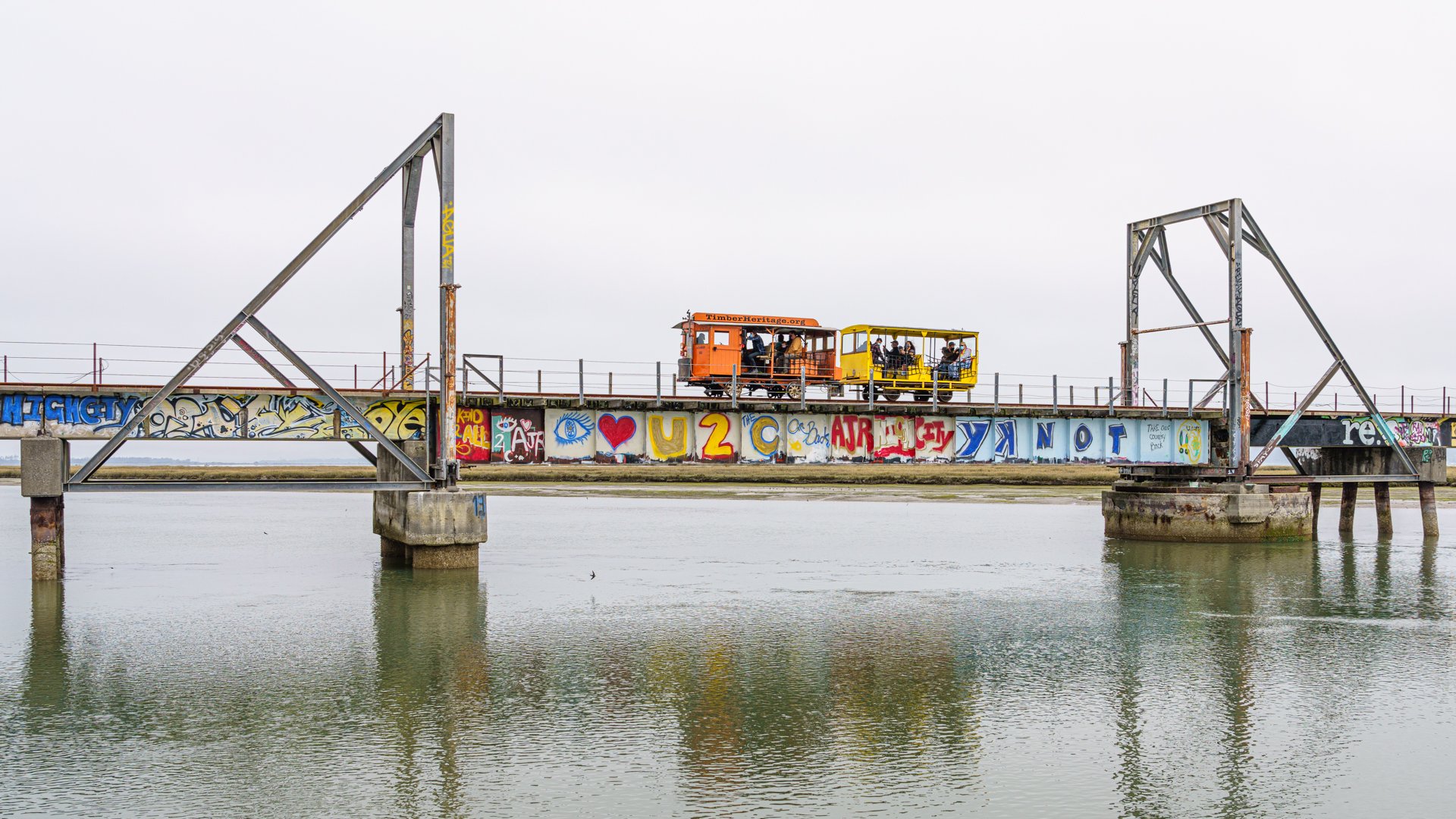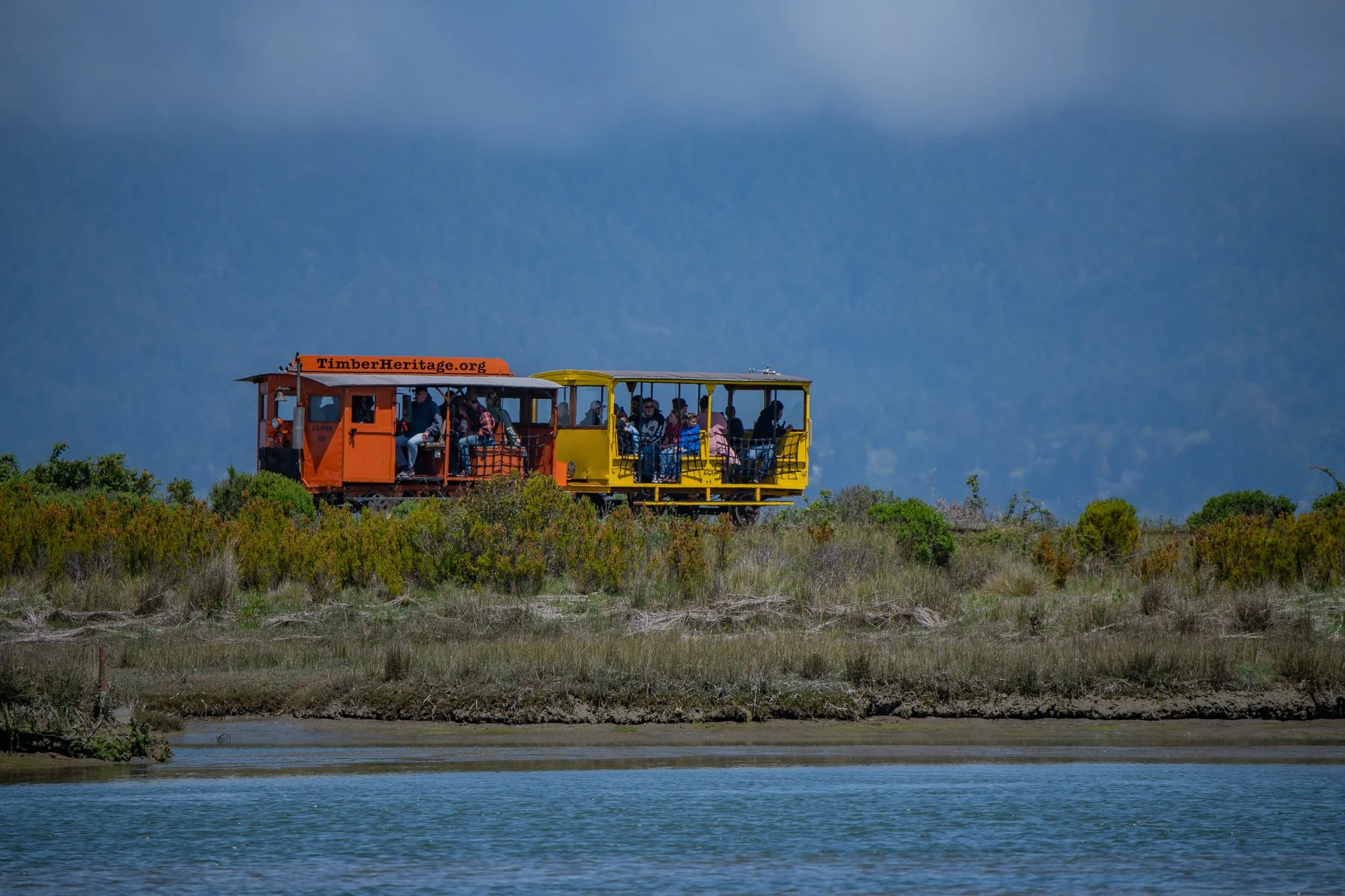
We are hoping to get back on the rails this summer!
But we need YOUR help! Our track has been in need of repair for over 30 years. In order to bring back our popular crew car rides, we need to restore our track back to it’s original glory. This is an expensive process and you can help us bring these tracks back to their original glory by buying a tie- or donating to help us buy bolts, spikes, and other track materials (OTM) including ballast. Your donation will help us to complete this process and make our tracks beautiful again. Follow the link below to help us get back on the rails!
RIDE THE RAILS ON A HISTORIC CREW CAR SPEEDER
Take a ride on Humboldt’s history with a scenic trip along the bay on Timber Heritage Association’s crew speeder! The Arcata and Mad River Railroad Crew Speeder car is a restored maintenance of way vehicle that traveled along the railways in Korbel.
Initially used for getting the logging crews out into the woods, crew speeders were a quick and efficient way to travel because they were faster than typical hand cars or human-powered rail vehicles. Getting a full-size locomotive up and running was no easy task back then! It was a slow process to get a steam engine up to pressure, not to mention the procedure of coupling some passenger cars, and it also required multiple specialized and experienced crew members.
Timber Heritage Association (THA) Volunteers restored the A&MRR in 2009 and began offering rides in the summer of 2009. During the winter of 2016-2017, the speeder was given a significant overhaul - now the rides are even smoother! In Winter 2022 the speeder was given some mechanical upgrades to improve reliability.
Both are great rides to see the flora and fauna of Humboldt Bay as well as some historic locations. These roughly ~25 minute rides begin at 10 a.m. and run until 4 p.m, with the last ride leaving around 4:00 p.m.
THE EUREKA SLOUGH RUN
Beginning in Halvorsen Park, under the Samoa Bridge, take a ride across the historic Eureka Slough Bridge and up to the Eucalyptus trees near the California Redwood mill & Murray Field.
THE SAMOA BRANCH RUN
Beginning at the foot of the Samoa Cookhouse on Vance Avenue, take a bayside ride toward Manila along some of the oldest railroad tracks in Humboldt County.
On these fourth Saturdays, our historic Samoa Shops are open for tours and you can see many of THA’s logging artifacts and locomotives on display. There are volunteers available to answer questions about the buildings, locomotives, and THA during these Samoa events.









FAQs
Where is the Eureka depot?
Under the CA 255 bridge in Eureka on Waterfront Drive.
Where is the Samoa depot?
Near the Samoa Cookhouse on Vance Avenue.
What is the suggested donation amount?
Adults (16+) $10.00
Seniors (60+) $8.00
Youth (2 to 8) $5.00
Children (0 to 24 mo) FREE
Under 18 must be accompanied by an adult.
If you have a group of 10 or more that would like to ride, please call Mike Kellogg at (707)-443-2957 to make a reservation prior to the day of the ride.
All scheduled events are subject to change and possible cancellation for any reason.
What is the history of the Eureka Old Town run?
Beginning at the foot of E Street in Eureka, ride through a vibrant district of shops, restaurants, galleries, and museums, which used to be home to Humboldt’s bustling port activity.
On April 8, 1901, the City of Eureka granted the California & Northern Railway the right to lay down tracks along the Eureka Waterfront. Almost immediately, crews began laying track from the Eureka Slough bridge toward the Carson Mansion and into J Street. A large tunnel was constructed through the hill the mansion sat on. Shortly after, on April 30, 1901, competitor Eureka & Klamath River Railroad was also granted a franchise by the City of Eureka and began constructing tracks along First Street between J & B Streets. The two companies came to a standstill as there was only enough room for one railroad through the congested Eureka Waterfront. Eventually, the two railroads compromised to create a single joint line through the town, but that did not end the fight for space. The battle over waterfront trackage rights raged until 1904, when the newly formed San Francisco & Northwestern Railway took over the line through Eureka.
What is the history of the Eureka Slough run?
Beginning in Halvorsen Park, under the Samoa Bridge, take a ride across the historic Eureka Slough Bridge and up to the Eucalyptus trees near the California Redwood mill & Murray Field.
The California & Northern Railway (C&NRR) company was incorporated to build a railroad between Eureka and Crescent City. The C&NRR first attempted to purchase a work-in-progress grade that the Eureka & Klamath River Railroad (E&KRR) had started south out of Arcata; however, they were refused. The C&NRR challenged the E&KRR by beginning to build north from Eureka through the bay mudflats. A drawbridge was built over the Eureka Slough, leading north toward Bracut, where C&NRR was rapidly cutting the grade through Brainard’s Point. In 1904 the newly formed San Francisco & Northwestern Railway took over the line, eventually becoming part of the Northwestern Pacific Railroad.
The Pacific Lumber Company once operated a branch railroad that went away from these tracks across Highway 101, alongside Murray Field Airport through the mudflats East to Freshwater. The trains went from Freshwater Corners deep into rich timberlands. The branch line to Freshwater was abandoned in 1941 and the rails were pulled for a WW2 scrap drive.
The Eureka Slough bridge has been rebuilt three times--it was first built as a lift bridge, replaced in 1916 as a truss swing bridge, and finally, in 1977, the current bridge was constructed. In 2023, the bridge was extensively retrofitted as part of the Humboldt Bay Trail South project.
Check out Humboldt Bay Shoreline, North Eureka to South Arcata: A History of Cultural Influences
What is the history of the Samoa branch run?
Beginning at the foot of the Samoa Cookhouse on Vance Avenue, take a bayside ride toward Manila along some of the oldest railroad tracks in Humboldt County.
The Eureka & Klamath River Railroad (E&KRR), also briefly known as the Oregon & Eureka Railroad - was initially incorporated to build a first-class passenger and freight railroad from Eureka to the Klamath River along the coast, with a ferry service connecting Eureka and Samoa. After many years of moving people and goods, the line was sold to Southern Pacific in 1903, which was developing an ambitious railroad between San Francisco, Eureka, and Coos Bay. The line made it through Fieldbrook to Trinidad during its height, and although plans were outlined, the line between Trinidad and Oregon never materialized.
The E&KRR was among the railroads consolidated by the Southern Pacific & Santa Fe into the newly organized Northwestern Pacific Railroad by 1911.
More about the Samoa branch run
In 1905, after Dolbeer & Carson’s contract to haul logs over the E&KRR ended, William Carson decided to construct a parallel line -- The Humboldt Northern Railway. The H. N. started from a location 1.2 miles north of the Samoa Roundhouse called Cole’s Landing -- this area is near the current highway bridge. Some of the large wood pilings sticking out of the bay near the peninsula are reminders of where the line once ran. The tracks crossed the Eureka & Klamath River Railroad just before Manila, continuing up the coast to McKinleyville and into the forest. It was near this location that Humboldt Northern locomotive #3 derailed into Humboldt Bay.
One morning in July 1923, the Humboldt Northern #3 was getting serviced in the shop at Cole’s landing. After the shop crew hooked it up to shop steam for some testing, they left for the Samoa Cookhouse to get some breakfast. Nobody had noticed that the Johnson bar was left in the reverse position. During their absence, the locomotive picked up enough steam to break free, rolling about a half-mile down the tracks where it hit a derail switch and fell into the muddy waters. H.N. #3 sat in the bay for months but was eventually rescued with the help of Mercer Fraser Co. The locomotive was fixed up and used by various railroads until 1955 when it sat unused for 32 years. In 1987, the locomotive was donated to the California State Railroad Museum, which eventually donated it to THA in 2008. #3 lives inside the Machine Shop in Samoa at the future Timber Heritage Museum.
What time are the Crew Speeder Rides?
Our volunteers usually operate the Crew Speeder Rides between 10 AM and 4 PM during the THA Summer season, which runs from May to September. Rides typically occur on the second and fourth Saturdays of the month. Each roundtrip ride lasts approximately 25 minutes. Keep in mind that these times are subject to change, and THA cannot guarantee specific timeslot availability. Unforeseen circumstances may lead to delays in your ride, so we recommend allotting extra wait time in your schedule.
What time of year are the Crew Speeder Rides?
The THA Summer season is between May and September. Typically on the second and fourth Saturdays of the month.
Will I be able to sit with my family or other party members?
Regrettably, we cannot guarantee that you will be able to sit with your family or other party members. Our speeders do not have assigned seating. Due to the characteristics of historical railway equipment, accommodating specific seating arrangements may be challenging.
I missed my Speeder ride. What should I do?
Unexpected situations can occur, and we understand. Kindly inform the attendant at the depot, so THA can assist you as effectively as possible. You have the option to request a refund of your donation, join the next available crew speeder, or save your ticket for a future ride. Please be aware that THA recommends allowing for extra waiting time in your schedule, and we may not be able to resolve all issues to your complete satisfaction.
Why are the events subject to change?
Some things are simply beyond our control. Weather can change or hazards may arise. Volunteers may have personal matters to attend to. THA does not own the train tracks outside of the Samoa Shops & Roundhouse complex property.

















